Institution Has Mastered the Art and Science of Being Entrepreneurial
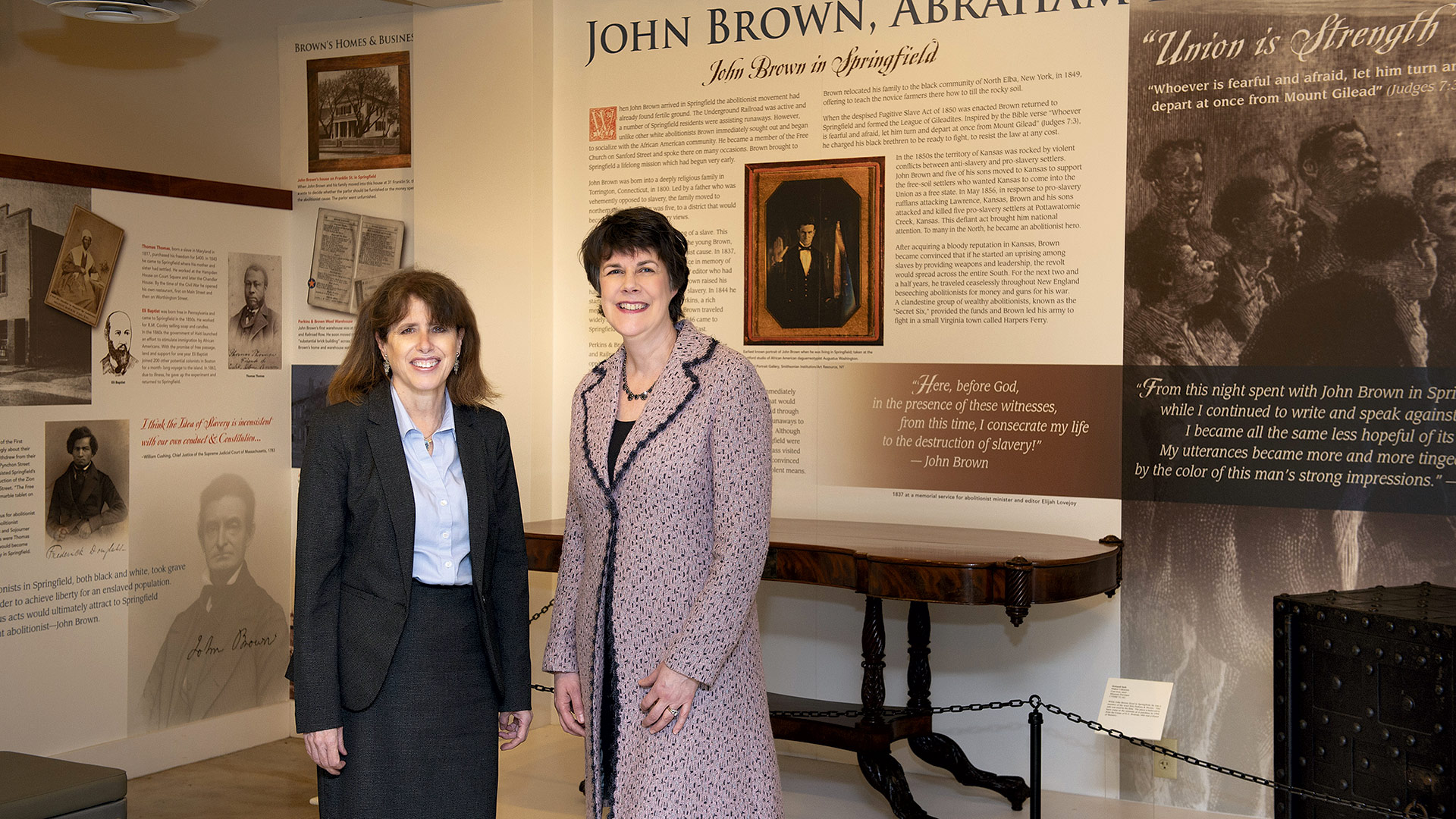
Kay Simpson, left, president and CEO of the Springfield Museums, with current board chair Kate Kane.
Kay Simpson says it wasn’t long after the Dr. Seuss National Memorial Sculpture Garden opened to the public in 2002 when the Springfield Museums first considered creating a special license plate to commemorate Seuss — and his hometown of Springfield.
That effort didn’t really get very far, she told BusinessWest, adding that the process of getting the state to produce these specialty license plates — there are now almost 30 of them that help raise money for causes and institutions ranging from the Jimmy Fund to Blackstone Valley to the Naismith Memorial Basketball Hall of Fame — was more involved then, and the thresholds to be met in terms of minimum numbers of subscribers were considerably higher. And 2002 was before the age of social media, when marketing such an effort was a much different proposition.
That was then.
With the opening in 2017 of the Amazing World of Dr. Seuss Museum, which has drawn visitors from across the state and around the world, Simpson and others at the Springfield Museums believe that threshold can be far more easily reached.
“We have 130 people signed up, and we need 750 signed on before we can actually put the plates into production; we’re well on our way, and there is considerable interest,” she explained, adding that there will eventually be an auction at which individuals can bid on the low plate numbers bearing the Seuss imagery.
A Dr. Seuss specialty plate could yield perhaps hundreds of thousands of dollars in revenue for the Museums over the next several years, said Simpson, but that windfall only begins to explain what the plate might mean for the institution and the City of Homes.
“It’s like a billboard, not just for the Museums, but for Springfield,” she told BusinessWest, in reference to the plate, which will bear an image of the most famous of all the Seuss characters, the Cat in the Hat. “The image says ‘seussinspringfield.org,’ which is our website, which tells the story of the Dr. Seuss museum, but it also celebrates Ted Geisel growing up in Springfield and all the connections he had to the city through his boyhood.
“This is not only going to be promoting the Quadrangle, the Amazing World of Dr. Seuss Museum, and the sculpture garden, but the city of Springfield as well,” she went on. “People living across the state can get one of these license plates, but people living in Massachusetts drive to all kinds of locations throughout the country, so this is a way of promoting the Museums and the city nationwide.”
“People living across the state can get one of these license plates, but people living in Massachusetts drive to all kinds of locations throughout the country, so this is a way of promoting the Museums and the city nationwide.”
So, in essence, a specialty license plate will only further amplify the already profound impact the Springfield Museums have had on the city and this region since the first collections, housed then in the Springfield Library, went on view back in 1857.
In the ensuing 162 years, the Museums have been a source of culture, history, and pride for generations of area residents, and they have also brought people from far outside this region into Springfield, effectively putting the city on the map.
And with many recent additions, especially the Dr. Seuss Museum, which doubled the institution’s visitation numbers in the first year it was open, the Museums’ overall impact has increased tremendously.
To the point where the decision makers at BusinessWest are making the Museums part of the Difference Makers class of 2019, thus taking the recognition program to a different dimension.
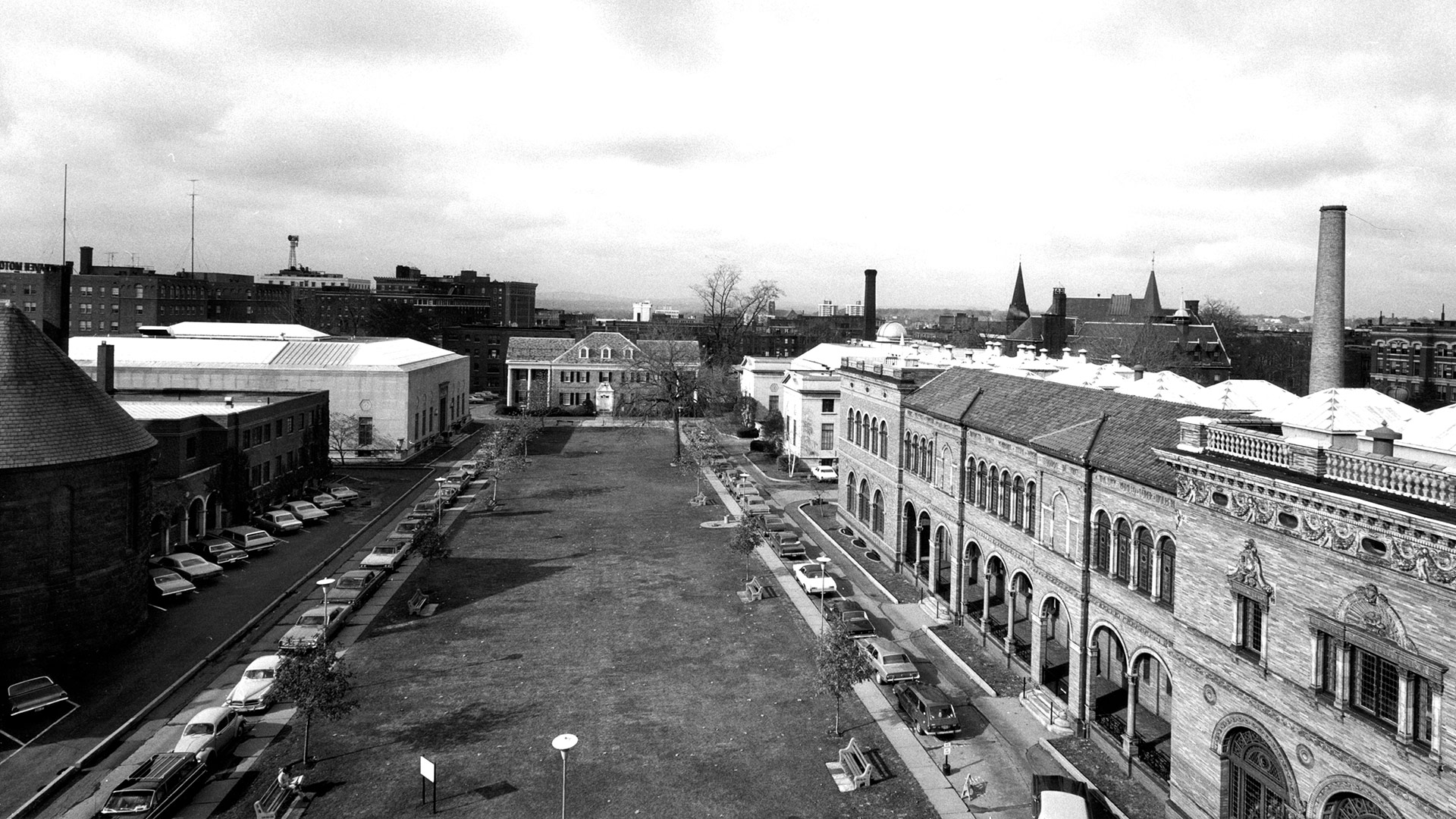
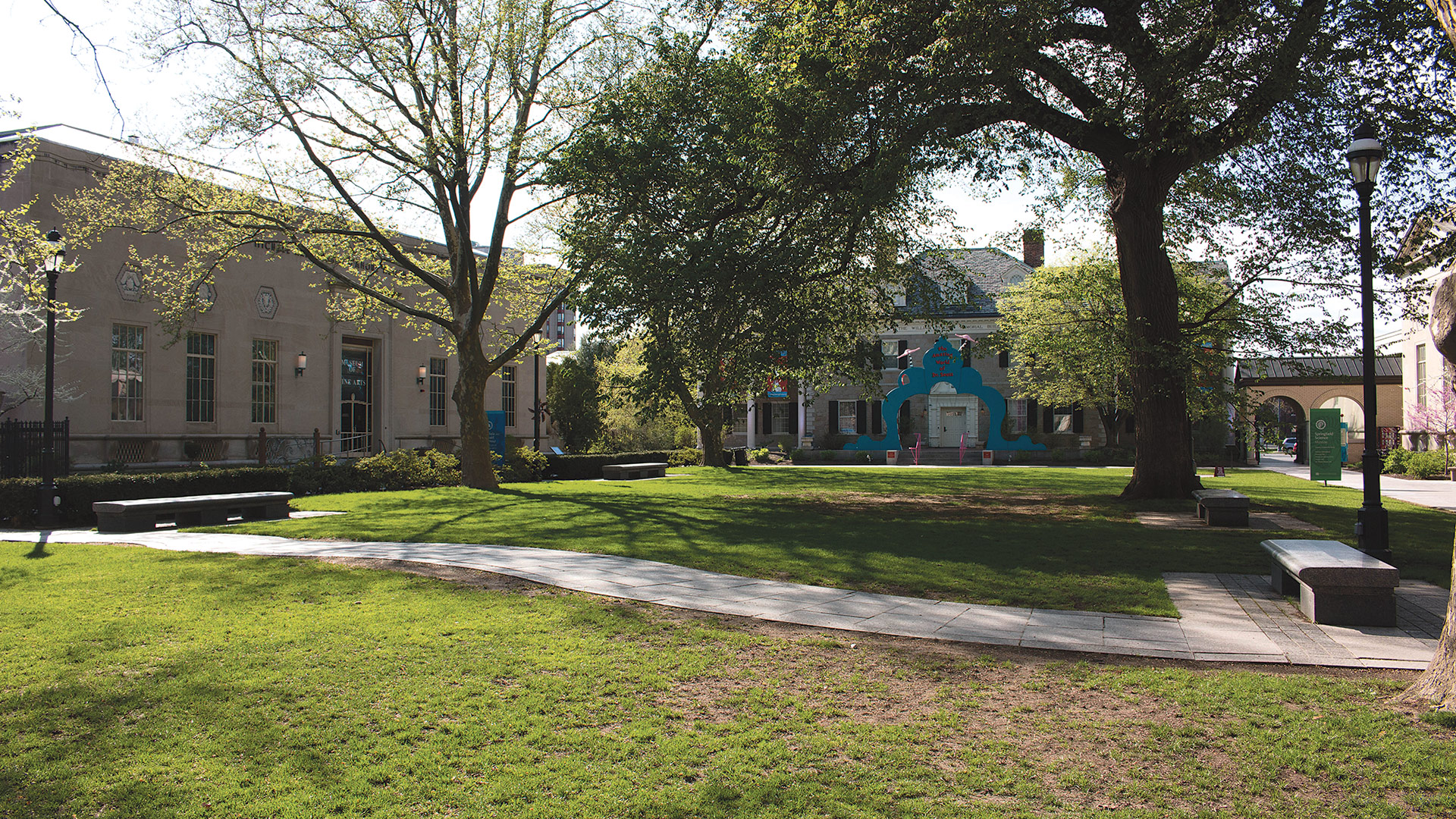
The Quadrangle has certainly changed over the years. Above, the scene in the early ’70s when one could actually drive onto the property. Below, today the scene is dominated by trees and the Dr. Seuss Memorial Sculpture Garden.
Indeed, over the past decade, the program has recognized individuals, families, a host of nonprofits (from Girls Inc. to Big Brothers Big Sisters), some of the region’s institutions of higher learning (UMass Amherst and the area’s community colleges, to be specific), and even a corporation — MassMutual.
But a cultural institution? The Museums would be the first. But they have collectively been a Difference Maker from the very beginning. Lyman Wood, retired business owner, philanthropist, mentor to many young professionals, and long-time supporter of the Museums — he and late wife, Merrie, have their names on the Museum of Springfield History — put things in their proper perspective:
“The Museums put us on the map,” he said, adding that the Seuss museum has made the city and the region only more visible in that respect. “But it’s more than that. The Museums touch every aspect of people’s lives, from the arts to the science to the culture; it’s a focus point for everyone.”
Moving forward, as it strives to go on being this focus point, the Museums will continue a pattern of thinking and operating that Kate Kane, chair of the Museums’ board of directors, described simply as “being entrepreneurial.”
Examples of this entrepreneurial mindset abound, from the license-plate initiative to the recent purchase of property adjacent to the history museum on Chestnut Street with the goal of transforming it into another potential attraction and revenue stream; from new exhibits like the current offerings ToyTopia (an interactive look at the history of toys) in the history museum and Dinosaur Discoveries in the Science Museum, to new, lower-priced, often-Seuss-themed items in the museum store that have triggered huge increases.
At a time when many museums are struggling to lure visitors and make ends meet, the Springfield Museums are enjoying considerable momentum and looking toward an even brighter future.
In short, an institution that has always been a Difference Maker is poised to become even more of one in the years and decades to come.
Making History
As she talked about the Museums, their history, and their evolution over the years, Simpson said that, while the individual museums are architectural masterpieces and many of the items on display within them have been under the same glass — figuratively and in some cases literally — for 50 or 100 years or more, they are far from static.
“The Museums touch every aspect of people’s lives, from the arts to the science to the culture; it’s a focus point for everyone.”
Indeed, they must change with the times in order to stand the test of time, she said, pointing out, as just one example, the Art of Discovery Center on the second floor of the George Walter Vincent Smith Art Museum, a 21st-century addition, if you will, to a late 19th-century facility, and that new Dinosaur Discoveries exhibit in the Science Museum.
The center provides drop-in activities during hours when the museum is open. Decorated with colorful and intricately painted floor-to-wall murals, the center’s hands-on activities provide insights into the culturally diverse collections on display in the museum’s galleries.
There are many other examples of how the old and the new — the past, the present, and sometimes the future — rush together in an almost seamless fashion at the museums, said Simpson, adding that this quality is one of many that make the collection of museums, which offer free admission to city residents, a historic landmark, a center for culture, and one of the leading tourist attractions in the region.
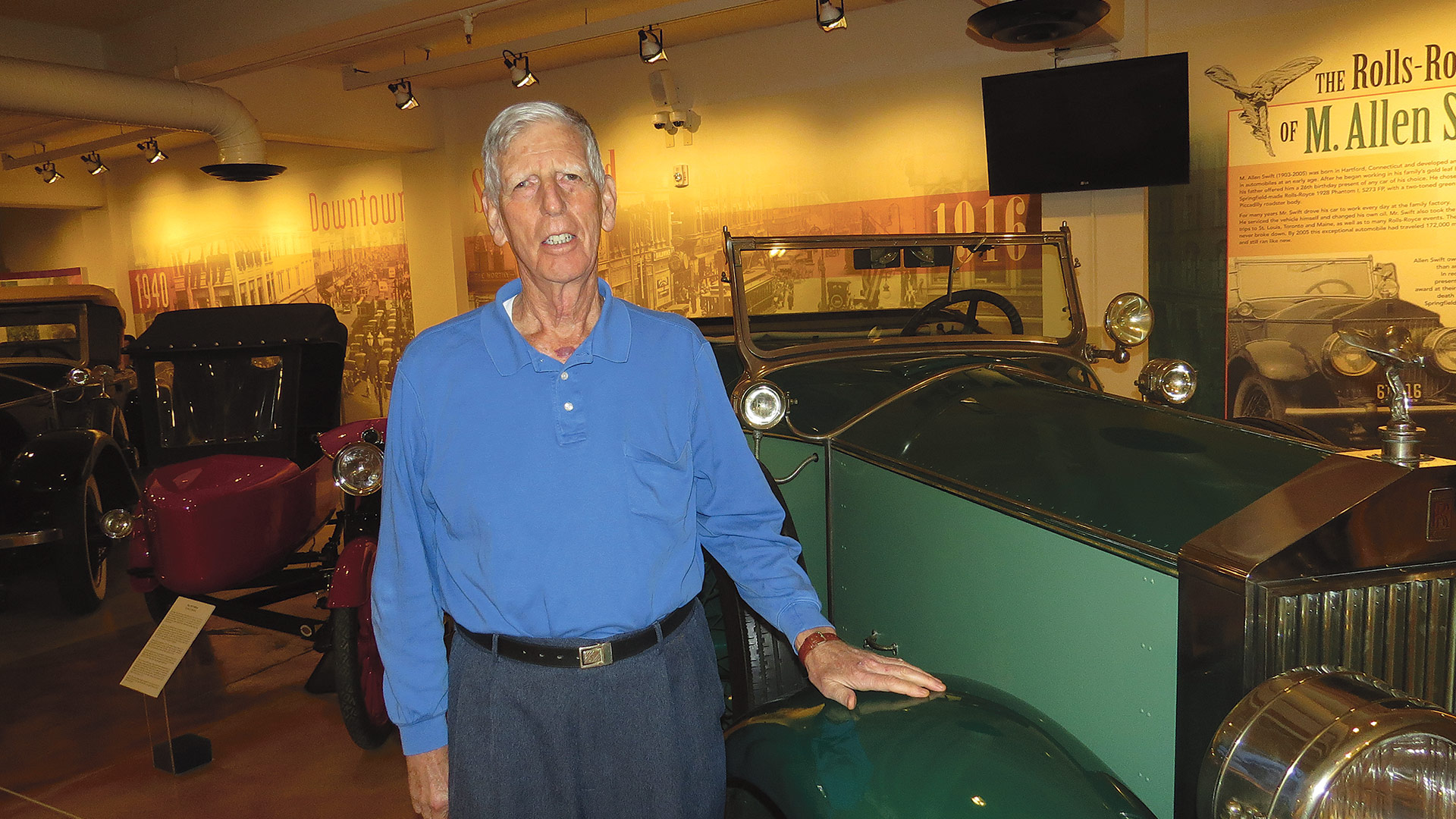
Lyman Wood, seen in the Lyman and Merrie Wood Museum of Springfield History, says the Museums have helped put Springfield on the map and bring more vibrancy to its downtown.
Evolution and building on past successes have been the blueprint for the Museums since the first items were put on display in the middle of the 19th century.
Indeed, the Springfield Museums trace their origins to 1857, when the Springfield and the Young Men’s Library Assoc. were joined to form the City Library Assoc. The earliest museum collections were housed in a room in City Hall.
In 1871, the museum collections were moved into a new library building, said Simpson, adding that, in 1888, George Walter Vincent Smith and his wife, Belle Townsley Smith, offered their collection to the association — a philanthropic act and one that would set the tone for many to come — that led to the construction of Springfield’s first museum.
The George Walter Vincent Smith Art Museum, an Italian palazzo-style building, opened its doors in 1896. The next addition to what would become a cluster of museums, or the Quadrangle, as it came to be called, was the Springfield Science Museum, which was founded in 1859 in City Hall and then moved in 1899 into a classical revival building that was expanded in 1932 and again in 1970, with the Tolman addition that included a public observatory.
Subsequent additions to the Quadrangle included the Connecticut Valley Historical Museum (1927), the Michelle and Donald D’Amour Museum of Fine Arts (1933), the Dr. Seuss National Memorial Sculpture Garden (2002), the Lyman and Merrie Wood Museum of Springfield History (2009), and the Amazing World of Dr. Seuss Museum, created in the original history museum, which opened in 2017.
And opened to considerable fanfare, said Simpson, adding that there was considerable, pent-up demand for a Seuss facility — visitors to the sculpture garden would habitually ask where the museum dedicated to the children’s book author was located and were disappointed when told there wasn’t one — and this was reflected in both the number of visitors and the long distances they traveled to walk under the arch at the front of the building.
Simpson told BusinessWest that, while the numbers speak loudly about the impact of the Seuss museum — attendance rose 110% in 2017 — it’s sometimes difficult to put into words exactly what that facility means for the Museums. But she tried, as did Wood.
“The opening of the Dr. Seuss Museum elevated the Museums in so many ways,” she explained. “It of course increased our attendance and, as a result, our revenue from ticketed admissions, which was very positive. But it also changed the character of our visitation; it really made us national and international, and while that might sound like an exaggeration, it really isn’t.

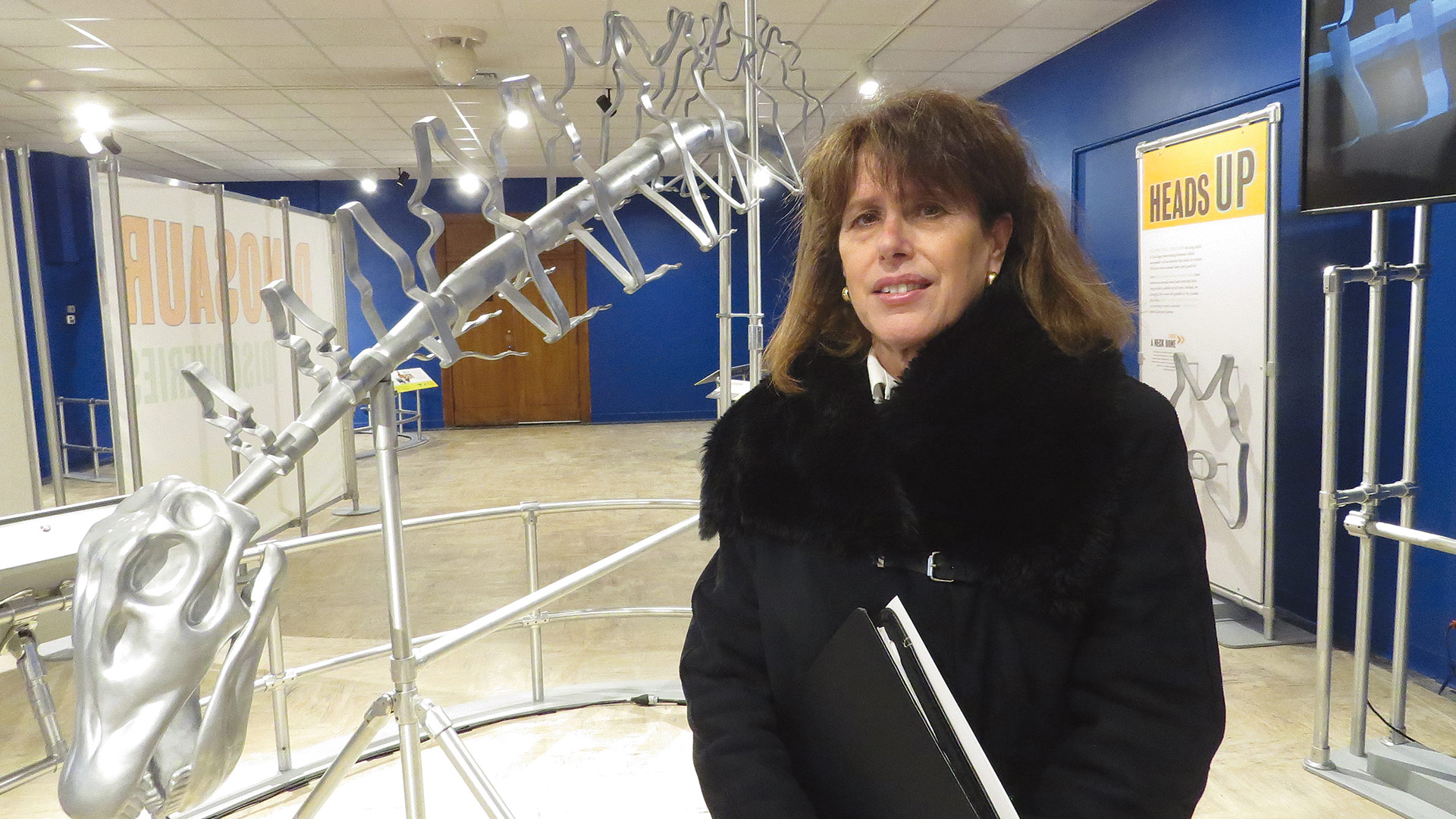
Above, the interior of the Science Museum in the mid-’30s. The facilities at the Quadrangle have all evolved with changing times and advancing technology. Below, Kay Simpson at the Dinosaur Discoveries special exhibit now at the Science Museum.
“We have the visitor-comment books that demonstrate that people travel here from Indiana and California and London because they wanted to see the Dr. Seuss Museum,” she went on, adding that, when they come — and those comment books indicate they’re also making repeat visits — they generally visit the other museums on the Quadrangle and often get out to see other parts of the city as well.
Wood agreed, and said that, collectively, the Museums, bolstered by the Dr. Seuss facility, will play a huge role in what he sees as the city’s best bet from a business and economic-development standpoint moving forward: tourism.
“To me, the future of Springfield, and I’ve been arguing this for 25 years, is going to be tourism,” he told BusinessWest. “We tried to get Fidelity out here, we’ve tried to be a tech center, we’ve made some good progress with communications, but if we’re really going to be on the map and have the vibrancy we all want, it’s going to come from tourism.”
And the Museums, along with MGM Springfield, the Basketball Hall of Fame, and other large attractions, will play a huge role in these efforts.
Entrepreneurship on Display
Overall, the Seuss Museum brings not only those aforementioned revenues — from not only admissions, but also the sale of items in the gift shop and, hopefully, those license plates — but also momentum and opportunity to expand and enhance its mission and do more to continue the evolutionary process of the individual museums.
In short, said Simpson, the Museums will continue to echo the entrepreneurial spirit so readily on display in the history museum, with its displays of Smith & Wesson guns, Indian motocycles, some of the first automobiles made in this country, several of Milton Bradley’s toys and games, and other products made in the city.
“The opening of the Dr. Seuss Museum elevated the Museums in so many ways. It of course increased our attendance and, as a result, our revenue from ticketed admissions, which was very positive. But it also changed the character of our visitation; it really made us national and international, and while that might sound like an exaggeration, it really isn’t.”
Plans to renovate and modernize the Science Museum are one example of being entrepreneurial and seizing opportunities, she said, adding that some of the halls are being improved in preparation for the opening of a Smithsonian SPARK Lab, a maker’s space that will bring more hands-on activities to the facility.
That lab is similar in nature to both the Art of Discovery Center in the George Walter Vincent Smith Art Museum and the so-called Cat’s Corner (named after the Cat in the Hat) in the Seuss Museum, a space on the second floor where children and families can take part in a host of facilitated art and literacy activities. Such facilities help prompt return visits, said Simpson, by providing new experiences each time one comes.
“With the SPARK Lab, you have this wonderful space with a changing curriculum where kids can go and engage in these open-ended activities that tie to STEM,” she explained. “And it is the Smithsonian, so it has that wonderful brand.”
The building on Chestnut Street that was acquired recently is still another example of the Museums being entrepreneurial, said Simpson. The space, currently occupied by a liquor store and a convenience store, could be put to a number of uses that could advance the institution’s mission and bring more people to the Quadrangle.
Possibilities include another maker’s space or perhaps a small bakery, much like the one operated by Ted Geisel’s maternal grandparents more than a century ago.
Overall, the broad goal for the Museums moving forward is to maintain their relevance, something many institutions, especially the living-history museums, are struggling to do in this day and age, she said, noting that, nationwide, attendance is down roughly 20% at museums across the board.
“When you talk about strategic planning, you can see it in terms of the evolution of the Quadrangle,” she said, referring to many of the recent changes, additions, and new, family-oriented exhibits. “You’re looking for those opportunities to make sure that what you’re offering is relevant to today’s audiences; you’re always building on the past.”
And building toward the future as well, said Kane, the board chair, who returned to that notion of being entrepreneurial.
“And what better place to follow that path than in Springfield?” she said, referencing the city’s long history of innovation and ‘firsts.’ “We can provide people with experiences that they can relate to and have value for them; it’s about making memories.”
Wood agreed. He said the Seuss Museum has brought attention to Springfield from across the state, across the country, and even from around the world, and it’s now incumbent on the institution to take full advantage of this development and build momentum moving forward.

The Amazing World of Dr. Seuss Museum doubled the Museums’ attendance in the first year it was open, greatly increasing revenues and creating more opportunities for the institution.
“What happened with the attendance that first year was remarkable, and it put us on the map with Boston,” he said. “We’ve received much more attention from the governor and the lieutenant governor — they’ve been out here to the Museums many times — and that means more people in the city and far outside the city are more aware of us. We have to build on that.”
Simpson concurred, and as she talked about the future, she returned once more to the past.
“When the Museums first opened, there was a statement made by one of the early founders that this was the ‘people’s college,’” she recalled, noting that phrase reflected a time when few people went to college. “I think that’s a wonderful expression, but I like to think of us more as the ‘people’s museum’ — there’s something for everyone, and we provide really substantial educational experiences for people of all ages.”
And it is now in a much better position to do that for generations to come.
Drive Time
Simpson said a date will soon be set for the auction involving those low, much-sought-after numbers for the Seuss specialty license plates. A few opportunistic individuals will emerge as big winners in that competition.
But over the past 161 years or so, the residents of Springfield and the region as a whole have all been big winners because of the Museums and all they have brought to the region — from art, science, and history to thousands of visitors and greater vibrancy.
Springfield was already on the map before 1857, when the first of the Museums’ exhibits went on display, but this institution has kept it there and promoted more people to circle that spot.
The Dr. Seuss Museum has taken the Quadrangle to a new and exciting place and made it a national and international attraction. But the reality is that this special collection of museums has always been a Difference Maker.
George O’Brien can be reached at [email protected]





